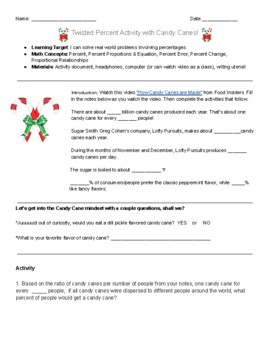"Twisted" Percent Activity How Candy Canes Made w/ video! % Change & Error
- PDF
- Easel Activity
Description
A fun, real world percent project! Answer key included.
Based on the video "How Candy Canes are Made" from Food Insiders. This hook takes students right into an activity/project that involves percent proportion and equation, percent change, percent error, and a proportional relationships extension problem. Students will use information from the video to answer percent problems where they find the percent, the whole, and the part! This is a great culminating activity, summative assessment, or interim assessment.
There is an Easel digital format included as well! This can be completed as a whole group activity, group assignment, or independent work. No prep needed once assigned! I also have fun graphic organizers listed for percent proportion and equations. If you would like the supplemental materials, please take a look!
This is great for any time of the year, but I love it as a holiday project! Keeps them busy before winter break! Though this is a candy themed activity, actual candy is not necessary for this project.
Thank you so much for taking a look at this activity!






